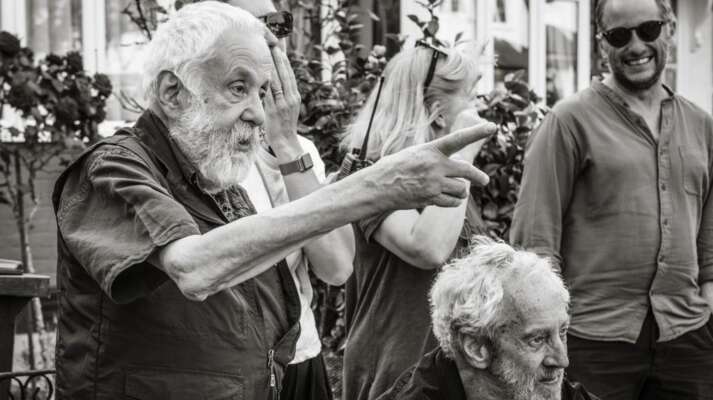Harriet Lauter | The Last Word
In Mark Pellington’s THE LAST WORD, Shirley MacLaine plays an 80-something woman who has built an impressively successful life by depending on no one but herself. In the twilight of her life, she attempts to secure her legacy by hiring a local newspaper writer, Anne Sherman (Amanda Seyfried), to pen her obituary, a gesture that proves challenging when they discover no one has anything good to say about her. “She knows that she has irritated a lot of people during her lifetime, but she wants to be remembered well,” explains MacLaine. To change the conversation, Harriet decides to change herself by doing something worth writing about. As THE LAST WORD unfolds, we witness how Harriet, in rewriting the last chapter of her life, seems to change the entire story. “It is about the lives we lead and the legacies we hope to leave behind, which people of all ages, both women and men, can relate to,” explains screenwriter Stuart Ross Fink.” To celebrate Harriet’s inspirational third act, we remember some remarkable people who created the work that defined their legacy in their golden years.
Laura Ingalls Wilder | A Novelist at 65

Generations of children have been enchanted by the simple, homespun life portrayed in Laura Ingalls Wilder’s series of Little House books. Even more people discovered her saga of pioneer life watching the seventies TV hit,
Little House on the Prairie, based on the third book in the collection. But this master of children’s literature didn’t begin her novels until she was 65 years old. And she was 76 when she published her last book,
These Happy Golden Years. Growing up in Wisconsin, Kansas, and South Dakota in the latter half of the 19th century, Wilder experienced firsthand the worlds she would later write about. After teaching in one-room schoolhouse in South Dakota, Wilder married in 1885 and moved to Missouri to tend a farm and raise a family. At 44, Wilder first stretched her literary muscles, writing a regular column, “As a Farm Woman Thinks,” in
The Missouri Ruralist. Dispensing handcrafted advice on farm chores and women’s education, Wilder developed a simple, but sturdy literary style. In the 1920s, she expanded her scope, writing about her own childhood in
When Grandma Was a Little Girl, an unpublished book that would become the basis for her later novels. It was, however, not encouragement from family and fans that pushed her to create the series that would make her name, but rather fear of financial ruin. After the 1929 stock market crash wiped out her family’s small holdings, Wilder came up with the books as a way to generate income, money that would become increasingly necessary as she grew older. Wilder published
Little House in the Big Woods, an account of her early childhood in Wisconsin, in 1932. Its huge success lead to eight more books collectively labeled the “Little House” series. Made wealthy by these books, Wilder retired to her farmhouse where she lived securely, frequently visited by fans and friends until her death in 1957.
Miguel de Cervantes | Introduces Don Quixote at 58

The Spanish novelist Miguel de Cervantes, whose fame is singularly tied to his great novel,
Don Quixote, didn’t publish his masterpiece until 1605 when he was 58. Born in 1547 to a professional middle-class family in a town northeast of Madrid, Cervantes floundered in early life, a victim mostly of his family’s own poverty. In 1569, at the age of 22, he fled to Rome to avoid a warrant issued against him for dueling. There he joined the Spanish Navy, distinguishing himself in a number of battles, even being captured and held prisoner in Algiers, before returning to Spain. Eventually settling in Toledo, Cervantes picked up minor government jobs, from requisitioning goods to serving as a tax collector. In his spare time, he started to find his literary voice. He penned a number of plays—most of which of which are lost––and in 1585, he published his first real work, a pastoral romance entitled
La Galatea. The book was never reprinted, and Cervantes’ luck soured as he was imprisoned twice for financial crimes related to his government jobs, although he was never found guilty for either charge. Like his famous hero, Cervantes tilted at windmills and found inspiration in the most unlikely of places. While jailed in Seville, he conceived of his grand adventure, the story of man so enamored of heroic tales that he sets off to be knight-errant himself. Using his own memories of battle and his experience traveling Spain as a bureaucrat, Cervantes wove a compelling, often comic vision of Spain and its people. Published in 1605, the book became an immediate success, from which Cervantes saw no reward since he sold off his publishing rights. But its fame turned Cervantes into a literary lion. He went on to publish a collections of plays, a volume of stories, a verse novel, an epic romance, and the second part of
Don Quixote in the eleven years before his death in 1616.
Peter Mark Roget | Finding the Right Words at 74

Nearly every student struggling over a term paper has reached out for
Roget’s Thesaurus without thinking much about its writer (see: scribe, amanuensis, scrivener, secretary, clerk…). In 1852, at the age of 74, Peter Mark Roget published the book that would immortalize him—and annoy English teachers––for years to come. As a young man, Roget was fascinated by science and taxonomies, as much as a survival technique as an intellectual curiosity. Early in his life, his uncle warned him, “Despondency is, I have always thought, the great defect of our family, and I do not think that you are more exempt from it then the rest.” Burdened with family tragedies––his father died early and his uncle committed suicide––and afflicted by depression, Roget took to making lists as a way to keep his obsessive and depressive nature at bay. As young man, he studied medicine at the University of Edinburgh. Upon graduating in 1798, he focused as much on research and writing as practicing medicine. During his long career, he penned treatises on optics, health, and physiology, as well as helped found the institution that would become the Royal Society of Medicine. Although he had been fascinated by words since 1805, he didn’t seriously undertake to collect them in a volume until after he retired from professional life. In 1852, he published his first collection,
Thesaurus of English Words and Phrases Classified and Arranged so as to Facilitate the Expression of Ideas and Assist in Literary Composition. The book became an immediate sensation, going through multiple reprints, with Roget tinkering with the lists of words in each reprint until his death in 1869.
Grandma Moses | Picked up a brush at 76

If there were ever a poster child for finding one’s calling later in life, it would be Grandma Moses. In 1936, Anna Mary Robertson Moses was 76 when she took up painting. Her sister suggested it might help her with the arthritis that was keeping her from embroidering. Within three years, her simple, rural tableaus were hanging in New York City’s Museum of Modern Art. Rather than paint directly what she saw, Moses created from memory, relishing and celebrating her past in the process. "I'll get an inspiration and start painting,” Moses explained about her method. “Then I'll forget everything, everything except how things used to be and how to paint it so people will know how we used to live." The simplicity and sincerity of Moses’s style appealed to both critics and public, making her a much beloved international figure. In her 1952 memoir,
My Life’s History, Moses laid out her philosophy: “I look back on my life like a good day's work. It was done and I feel satisfied with it. I was happy and contented, I knew nothing better and made the best out of what life offered." She continued to work till 1960 when she died at the age of 101. At her death, President John F. Kennedy praised her accomplishment, saying, “The directness and vividness of her paintings restored a primitive freshness to our perception of the American scene.”
Julia Child | The French Chef at 51

Through the sixties and seventies, audiences hungrily savored the booming voice of Julia Child on
The French Chef. Every week Child brought culinary techniques and lots of butter to America before signing off with her tagline, “Bon appétit!" But Child was 51 before becoming TV’s first top chef. Raised in Southern California to an upper-class family, Child (née McWilliams) led an active, athletic life, playing tennis, golf and basketball. But she never learned to cook. After graduating from Smith College, Child joined the Office of Strategic Services (OSS) where she worked closely with the head of intelligence, General William J. Donovan. There, the closest she came to cooking was concocting a chemical solution to repel sharks from ramming into underwater explosives. It was not till she married Paul Child and moved to Paris in 1948 that she had her first true culinary encounter. A lunch of oysters, sole, and a green salad at La Couronne produced an epiphany. “The whole experience was an opening up of the soul and spirit for me,” Child writes, “I was hooked, and for life, as it turned out.” While her husband worked at the State Department, Child threw herself into French cuisine: studying at Le Cordon Bleu, joining a women’s cooking club, and creating her own small cooking school for American women in Paris. All the while, Child worked with two other women, Simone Beck and Louisette Bertholle, to collect recipes for a book that would introduce French cuisine to an American audience. The 726-page
Mastering the Art of French Cooking was initially rejected before being published in 1961, becoming a surprise bestseller. Child might have remained simply a name on a humongous cookbook if not for a chance promotional segment on Boston’s WBBH-TV book show, “I’ve Been Reading.” Her on-air preparation of an omelet proved so popular that 27 people wrote in that day saying they wanted to see more of her and her cooking. Her show
, The French Chef, premiered in 1963 on Boston’s public TV station. When it started,
TIME Magazine reports that its budget was so small that “volunteers had to be recruited to wash dishes, and the food sometimes had to be auctioned off to the audience afterward to cover expenses.” By 1965, the show was carried on 66 stations and Child, who would go on to the ripe old age of 91, had become a national icon.
Duncan Hines | A Grocery Staple at 72
 Duncan Hines, who rose to the top of the baking world with his brand of boxed cake mixes in 1952, was 72 when he made his mark. Born in Kentucky in 1880, Hines was a man shaped by the food he ate. When his mother died when he was just four, he was shipped to live with his grandmother, who, as Hines remembers, raised him on “apple pie, pecan pie, … country ham, candied yams, turnip greens with fatback, beaten biscuits and cornbread.” Ending up in Chicago, he worked as a traveling salesman who took his love of eating on the road, taking notes of the best––and worst––of the diners and cafes he stopped in along the way. At 56, he published his first book, Adventures in Good Eating, a culinary tour book, that eventually lead to a syndicated newspaper column. In the biography,Duncan Hines: How a Traveling Salesman Became the Most Trusted Name in Food, Louis Hatchett writes that “Americans regarded his every word with the highest esteem.” Having become the name people turned to when going out to dinner, businessman Roy Park wondered if Hines could not also be the figure shoppers trusted at the grocery store. In 1952, the pair started working on a line of Duncan Hines products, including his cake mixes. Within a few years, Hines sold off the business, keeping a percentage from his branded merchandise till he died in 1959. While he was not particularly involved in the products that carried his trademark, his name continued to have universal appeal. In the sixties, Proctor and Gamble market research determined that 99% of shoppers recognized and trusted the name “Duncan Hines.”
Duncan Hines, who rose to the top of the baking world with his brand of boxed cake mixes in 1952, was 72 when he made his mark. Born in Kentucky in 1880, Hines was a man shaped by the food he ate. When his mother died when he was just four, he was shipped to live with his grandmother, who, as Hines remembers, raised him on “apple pie, pecan pie, … country ham, candied yams, turnip greens with fatback, beaten biscuits and cornbread.” Ending up in Chicago, he worked as a traveling salesman who took his love of eating on the road, taking notes of the best––and worst––of the diners and cafes he stopped in along the way. At 56, he published his first book, Adventures in Good Eating, a culinary tour book, that eventually lead to a syndicated newspaper column. In the biography,Duncan Hines: How a Traveling Salesman Became the Most Trusted Name in Food, Louis Hatchett writes that “Americans regarded his every word with the highest esteem.” Having become the name people turned to when going out to dinner, businessman Roy Park wondered if Hines could not also be the figure shoppers trusted at the grocery store. In 1952, the pair started working on a line of Duncan Hines products, including his cake mixes. Within a few years, Hines sold off the business, keeping a percentage from his branded merchandise till he died in 1959. While he was not particularly involved in the products that carried his trademark, his name continued to have universal appeal. In the sixties, Proctor and Gamble market research determined that 99% of shoppers recognized and trusted the name “Duncan Hines.”





 Duncan Hines, who rose to the top of the baking world with his brand of boxed cake mixes in 1952, was 72 when he made his mark. Born in Kentucky in 1880, Hines was a man shaped by the food he ate. When his mother died when he was just four, he was shipped to live with his grandmother, who, as Hines remembers, raised him on “apple pie, pecan pie, … country ham, candied yams, turnip greens with fatback, beaten biscuits and cornbread.” Ending up in Chicago, he worked as a traveling salesman who took his love of eating on the road, taking notes of the best––and worst––of the diners and cafes he stopped in along the way. At 56, he published his first book, Adventures in Good Eating, a culinary tour book, that eventually lead to a syndicated newspaper column. In the biography,Duncan Hines: How a Traveling Salesman Became the Most Trusted Name in Food, Louis Hatchett writes that “Americans regarded his every word with the highest esteem.” Having become the name people turned to when going out to dinner, businessman Roy Park wondered if Hines could not also be the figure shoppers trusted at the grocery store. In 1952, the pair started working on a line of Duncan Hines products, including his cake mixes. Within a few years, Hines sold off the business, keeping a percentage from his branded merchandise till he died in 1959. While he was not particularly involved in the products that carried his trademark, his name continued to have universal appeal. In the sixties, Proctor and Gamble market research determined that 99% of shoppers recognized and trusted the name “Duncan Hines.”
Duncan Hines, who rose to the top of the baking world with his brand of boxed cake mixes in 1952, was 72 when he made his mark. Born in Kentucky in 1880, Hines was a man shaped by the food he ate. When his mother died when he was just four, he was shipped to live with his grandmother, who, as Hines remembers, raised him on “apple pie, pecan pie, … country ham, candied yams, turnip greens with fatback, beaten biscuits and cornbread.” Ending up in Chicago, he worked as a traveling salesman who took his love of eating on the road, taking notes of the best––and worst––of the diners and cafes he stopped in along the way. At 56, he published his first book, Adventures in Good Eating, a culinary tour book, that eventually lead to a syndicated newspaper column. In the biography,Duncan Hines: How a Traveling Salesman Became the Most Trusted Name in Food, Louis Hatchett writes that “Americans regarded his every word with the highest esteem.” Having become the name people turned to when going out to dinner, businessman Roy Park wondered if Hines could not also be the figure shoppers trusted at the grocery store. In 1952, the pair started working on a line of Duncan Hines products, including his cake mixes. Within a few years, Hines sold off the business, keeping a percentage from his branded merchandise till he died in 1959. While he was not particularly involved in the products that carried his trademark, his name continued to have universal appeal. In the sixties, Proctor and Gamble market research determined that 99% of shoppers recognized and trusted the name “Duncan Hines.”

